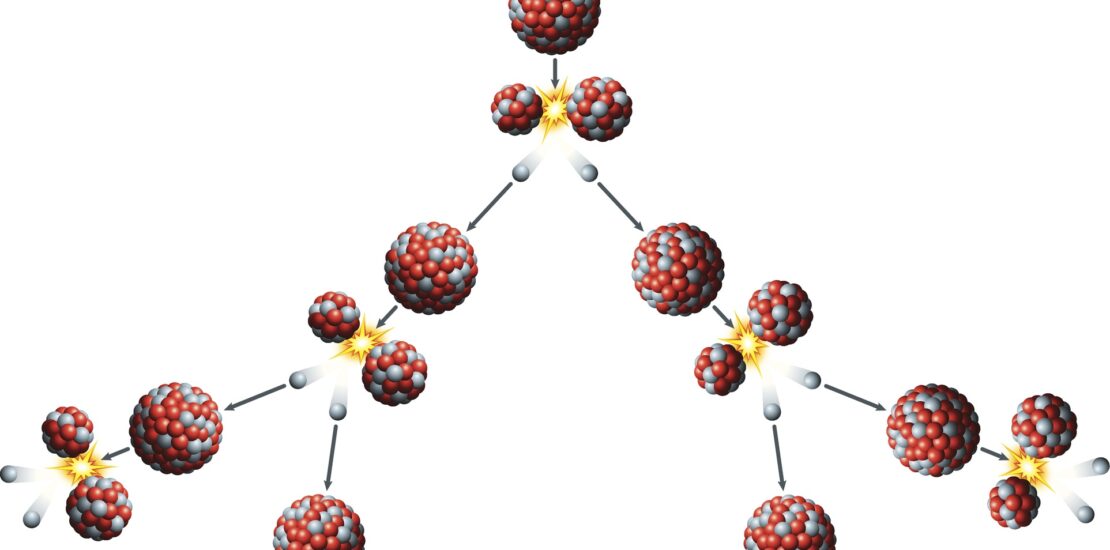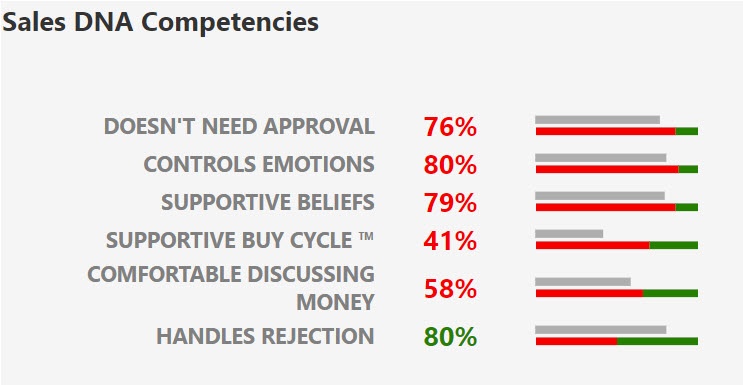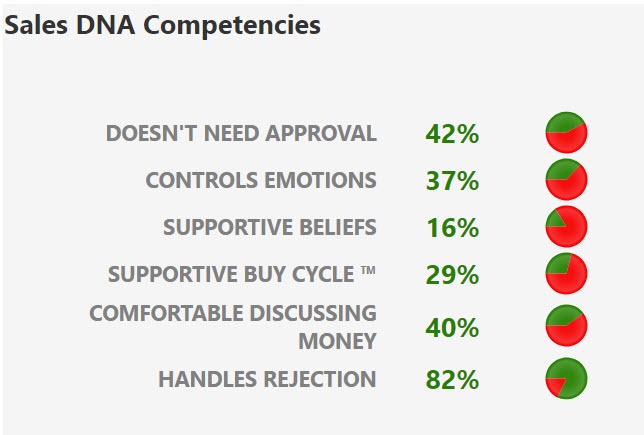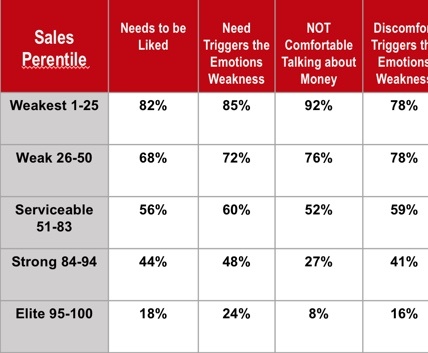- May 30, 2018
- Posted by: Dave Kurlan
- Category: Understanding the Sales Force

I have written extensively about Sales DNA over the years and today we will view Sales DNA from the perspective of sitting inside of a chemistry lab.
Sales DNA is the combination of strengths (or weaknesses) that support (or sabotage) the execution of sales process, sales strategy and sales tactics. Objective Management Group (OMG) measures and includes the 6 most powerful of those strands of Sales DNA in its 21 Sales Core Competencies. While I usually discuss the impact of these weaknesses, we have never conducted a lab experiment like this before!
John Pattison, the COO at OMG, built a new tool for us to play with. It allows us to slice and dice the data in ways never before possible (for us). I feel like a kid with a new train set but that analogy ages me. I feel like a kid with a new PlayStation!
The image below shows the average scores for all salespeople in the 6 Sales Core Competencies of Sales DNA.

The average scores for all salespeople are not very good! The next image shows the percentage of all salespeople who have those 6 Competencies as strengths. This isn’t very good either.

You can see all of our data in all 21 Sales Core Competencies and filter it by industry and company here.
Most experiments begin with a theory or a question. My theory is that Sales DNA is similar to a chemical reaction whereby if a salesperson has 2 or more of the 6 above as weaknesses, and #2 is the tendency to become emotional, then weakness #1 will trigger weakness #2.
A weakness is triggered when salespeople are aware of the need to execute a step, strategy or tactic, like asking a specific question, but are worried that the prospect will dislike them for doing so. As a result, they avoid executing and thereby sabotage themselves.
DOESN’T NEED APPROVAL: As a weakness, it causes salespeople to avoid an action when they worry that their prospects won’t like them. Prevents salespeople from asking tough questions, pushing back and challenging their prospects, the core skills to selling like a Challenger.
CONTROLS EMOTIONS: As a weakness, it occurs when salespeople worry, strategize, panic or get excited. This causes them to get in their own heads, and prevents them from being able to actively listen and ask good questions, the core skills of a consultative approach to selling.
COMFORTABLE DISCUSSING MONEY: As a weakness, salespeople aren’t comfortable asking a prospect where their money is coming from, how they might find money they don’t have, how they might find more money than what was budgeted, or how to prioritize expenditures to solve their problems.
Let the experiment begin!
The first Competency I tested was Doesn’t Need Approval or, whether or not a salesperson NEEDS to be liked.
58% of all salespeople Need to be Liked (a weakness) and their average score is 76 (weak).
When I sliced the data with Controls Emotions you can see what I found in the table below:

66% of salespeople who need their prospects to like them become emotional when the weakness is triggered. 2/3 of them!
I wondered how much that percentage might change based on our Sales PercentileTM score so I dug deeper and learned that:
The bottom 25% of all salespeople, almost all of them at 85% – become emotional when the need to be liked is triggered.
For those in the percentiles between 26 and 50, 72% become emotional when the need to be liked is triggered.
Salespeople in the percentiles between 51 and 75 were less likely to become emotional when the need to be liked is triggered. It happens with 60% of them.
Only 41% of the salespeople in the percentiles between 76-94 (strong) have the need to be liked but when it is triggered, 46% of that group become emotional.
Only 18% of elite salespeople (the top 5%) have the need to be liked but when it is triggered, 24% of them become emotional.
* * * *
I ran the same experiment on Comfortable Discussing Money. As with the need to be liked, 60% of all salespeople have this as a weakness.
67% of those who are not comfortable discussing finances become emotional at the moment the money weakness is triggered. Again, it’s two thirds of them!
As with the need to be liked, the percentage changed according to Sales PercentileTM so here is what happens:
78% of the salespeople in the bottom 50% become emotional when the money weakness is triggered.
59% of the salespeople in the percentiles between 51 and 75 become emotional when the money weakness is triggered.
Only 34% of salespeople in the percentiles between 75-95 are uncomfortable discussing money but when the weakness is triggered, 41% of that group become emotional.
Only 8% of elite salespeople (the top 5%) are uncomfortable talking about money, but when the weakness is triggered, 17% of them become emotional.
Upon the triggering of the first weakness, these findings show that for most salespeople with more than 1 major weakness along with the tendency to become emotional, the emotions weakness is triggered as part of a chain reaction.
The data also confirms that nearly all of the weakest salespeople (Sales Percentile below 25) have these weaknesses (and more) and the 1st weakness almost always triggers the 2nd weakness.
Finally, the data confirms that very few of the salespeople in the elite top 5% have these weaknesses and when they do it is far less likely for the 2nd weakness to be triggered with the 1st.
When everyone on the sales force receives the exact same sales training and coaching, these findings explain why top salespeople continue to succeed while poor salespeople fail to show measurable improvement
Image Copyright iStock Photos
